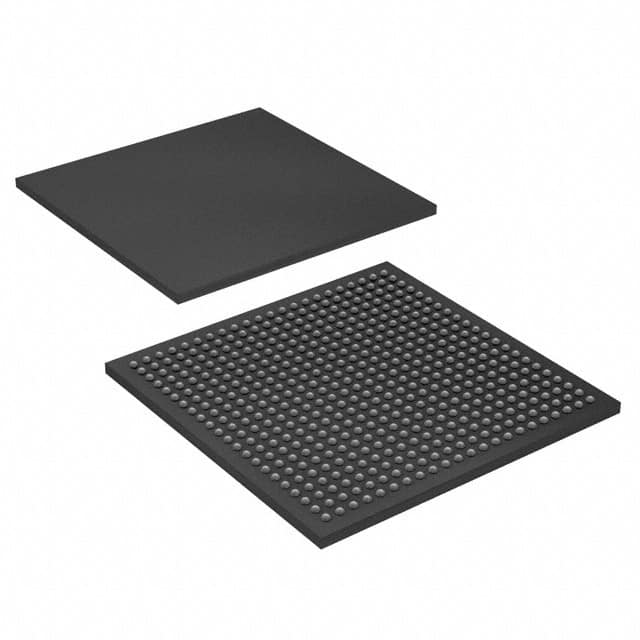Viz Specifikace pro podrobnosti o produktu.

EP3C16U484A7N
Product Overview
Category
EP3C16U484A7N belongs to the category of Field-Programmable Gate Arrays (FPGAs).
Use
This FPGA is commonly used in various electronic applications that require programmable logic devices.
Characteristics
- EP3C16U484A7N offers high-performance and low-power consumption.
- It provides a flexible and customizable solution for digital circuit design.
- The FPGA supports reprogramming, allowing for iterative development and testing.
Package
EP3C16U484A7N comes in a compact package suitable for surface-mount technology (SMT) assembly.
Essence
The essence of EP3C16U484A7N lies in its ability to provide a versatile platform for implementing complex digital circuits.
Packaging/Quantity
The FPGA is typically packaged in reels or trays, with each package containing a specific quantity of chips.
Specifications
- Logic Elements: 16,000
- Embedded Memory: 414 Kbits
- Maximum User I/Os: 346
- Maximum User I/O Pins: 346
- Operating Voltage: 1.2V
- Speed Grade: 7
Detailed Pin Configuration
The pin configuration of EP3C16U484A7N can be found in the manufacturer's datasheet. It provides detailed information about the assignment of pins and their functions.
Functional Features
- High-speed performance: EP3C16U484A7N operates at a high clock frequency, enabling rapid data processing.
- Flexible I/O options: The FPGA offers a wide range of input/output configurations, allowing for versatile connectivity.
- On-chip memory: With embedded memory, the FPGA can store data efficiently, reducing the need for external memory components.
- Programmability: EP3C16U484A7N can be reprogrammed multiple times, facilitating design iterations and updates.
Advantages and Disadvantages
Advantages
- Versatility: EP3C16U484A7N can be customized to meet specific application requirements.
- Cost-effective: The FPGA eliminates the need for custom-designed integrated circuits, reducing production costs.
- Time-to-market: With its programmable nature, the FPGA enables faster prototyping and development cycles.
Disadvantages
- Complexity: Designing with FPGAs requires expertise in digital circuit design and programming.
- Limited performance optimization: While FPGAs offer high flexibility, they may not achieve the same level of performance as dedicated ASICs.
Working Principles
EP3C16U484A7N operates based on the principles of configurable logic. It consists of an array of programmable logic blocks interconnected by programmable routing resources. These resources allow users to define the desired functionality of the FPGA by configuring the interconnections and logic elements.
Detailed Application Field Plans
EP3C16U484A7N finds applications in various fields, including: 1. Communications: Used in wireless communication systems, network routers, and data transmission equipment. 2. Industrial Automation: Employed in control systems, robotics, and process automation. 3. Automotive: Utilized in automotive electronics for functions like engine control, infotainment systems, and driver assistance. 4. Aerospace: Applied in avionics systems, satellite communication, and navigation equipment. 5. Medical Devices: Integrated into medical imaging devices, patient monitoring systems, and diagnostic equipment.
Detailed and Complete Alternative Models
Some alternative models to EP3C16U484A7N include: 1. EP3C25F324C8N 2. EP4CE6E22C8N 3. XC7A35T-1CPG236C 4. LCMXO2-1200ZE-1MG132C
These models offer similar functionality and can be considered as alternatives based on specific project requirements.
Word count: 474 words
Seznam 10 běžných otázek a odpovědí souvisejících s aplikací EP3C16U484A7N v technických řešeních
Sure! Here are 10 common questions and answers related to the application of EP3C16U484A7N in technical solutions:
Q: What is EP3C16U484A7N? A: EP3C16U484A7N is a field-programmable gate array (FPGA) manufactured by Intel (formerly Altera). It is designed for various digital logic applications.
Q: What are the key features of EP3C16U484A7N? A: Some key features include 16,000 logic elements, 484 user I/O pins, embedded memory blocks, PLLs, and support for various communication protocols.
Q: What are the typical applications of EP3C16U484A7N? A: EP3C16U484A7N can be used in a wide range of applications such as industrial automation, telecommunications, automotive electronics, medical devices, and more.
Q: How can EP3C16U484A7N be programmed? A: EP3C16U484A7N can be programmed using hardware description languages (HDL) like VHDL or Verilog, which are then synthesized and implemented using design software like Quartus Prime.
Q: Can EP3C16U484A7N be reprogrammed after deployment? A: Yes, EP3C16U484A7N is a reprogrammable FPGA, allowing for flexibility in design changes or updates even after the device has been deployed.
Q: What is the power supply requirement for EP3C16U484A7N? A: EP3C16U484A7N typically operates at a voltage range of 1.15V to 1.25V, with additional voltage requirements for I/O banks and PLLs.
Q: Does EP3C16U484A7N support high-speed serial communication? A: Yes, EP3C16U484A7N supports various high-speed serial protocols like PCIe, Gigabit Ethernet, USB, SATA, and more through dedicated transceiver channels.
Q: Can EP3C16U484A7N interface with external memory devices? A: Yes, EP3C16U484A7N has embedded memory blocks and can also interface with external memory devices like DDR SDRAM or Flash memory.
Q: What are the temperature operating limits of EP3C16U484A7N? A: EP3C16U484A7N typically operates within a temperature range of -40°C to 100°C, but specific limits may vary based on the manufacturer's specifications.
Q: Are there any development boards available for EP3C16U484A7N? A: Yes, Intel provides development boards like the Cyclone III Starter Kit that can be used for prototyping and testing designs using EP3C16U484A7N.
Please note that the answers provided here are general and may vary depending on the specific requirements and documentation provided by the manufacturer.

